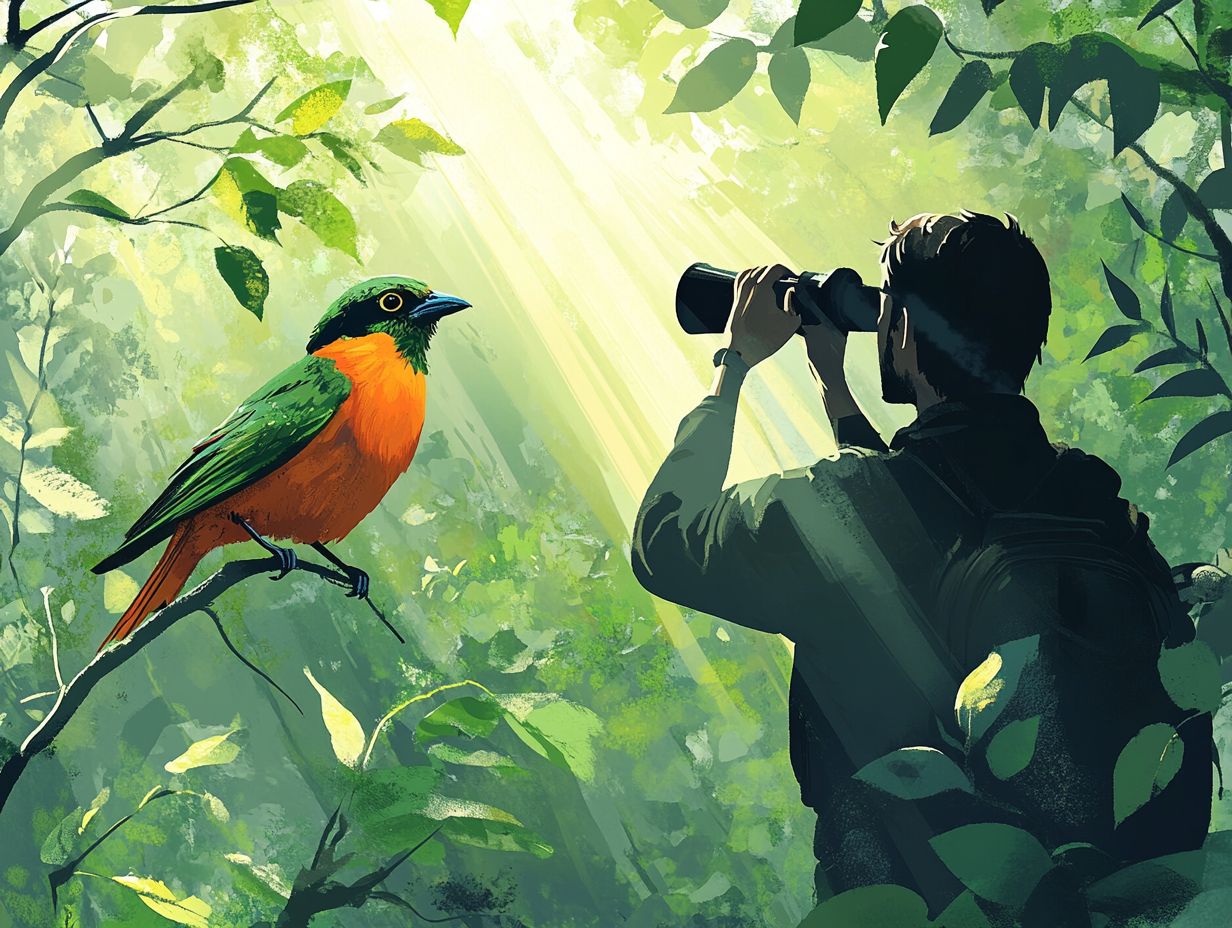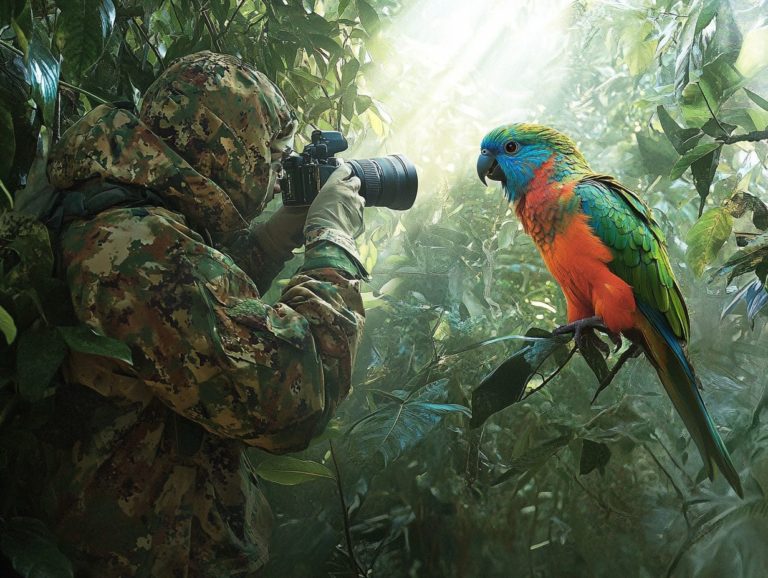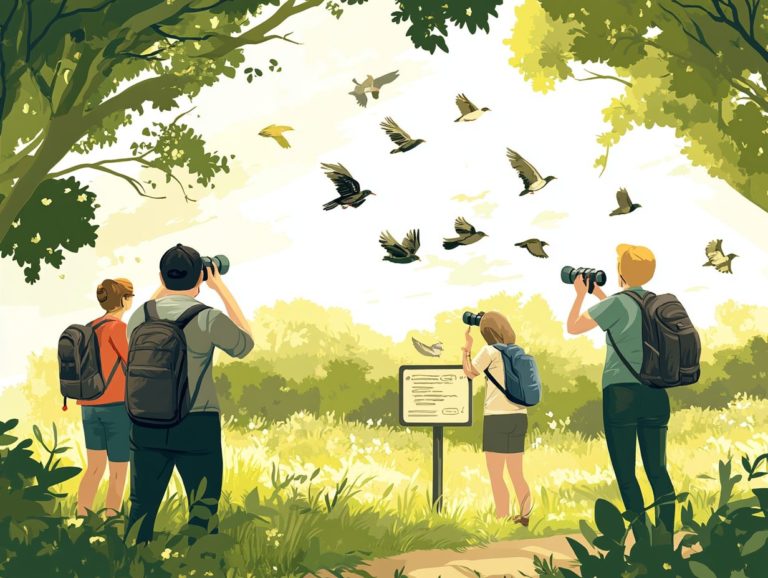What to Do When You Spot a Rare Bird?
Birdwatching transcends mere leisure; it unfolds as an exhilarating adventure that connects you with the wonders of nature.
Spotting a rare bird isn’t just a moment; it’s a thrilling experience that fills you with a sense of accomplishment and excitement.
This guide explores what makes a bird rare, outlines essential gear you’ll need, and provides insights into identifying these elusive creatures.
Proper etiquette is crucial for protecting the birds and their habitats. Your sightings can also play a vital role in conservation efforts.
Immerse yourself in this exploration of rare birds and elevate your birdwatching journey!
Contents
Key Takeaways:

- Respect birds and their homes while birdwatching.
- Prepare for bird spotting by researching locations and behaviors of rare birds. Bring essential gear to enhance your experience.
- Record and report any rare bird sightings to help with conservation efforts.
What Makes a Bird Rare?
A bird is deemed rare when its population dips significantly below the norm, often due to factors like habitat loss, climate change, or certain environmental needs that restrict its presence in specific areas. Conservationists and birdwatchers recognize that local rarity can vary greatly based on how birds respond to environmental changes.
Understanding what makes a bird rare deepens your knowledge of bird study and aids in conserving the variety of life, especially where wildlife is threatened.
Several factors contribute to this rarity, including invasive species that disrupt food sources and nesting sites. For instance, the Hawaiian honeycreepers face fierce competition from non-native birds. The loss of wetlands has significantly impacted migratory shorebird populations, leading to alarming declines.
Conservation scientists keep an eye on at-risk birds using methods like tagging and checking their homes. Meanwhile, the birding community raises public awareness through initiatives like bird counts and citizen science projects, fostering a collective responsibility for preserving these extraordinary species.
Why Spotting Rare Birds is Exciting
Spotting rare birds is one of the most exhilarating experiences you can have as a birder. You ll be amazed by the breathtaking beauty of avian diversity while engaging with a community that shares your passion for wildlife observation.
Whether you re thrilled by the sighting of a vagrant like the Northern Hawk-Owl or Kirtland s Warbler, or focused on capturing photographic evidence of these elusive species, you ll find that both photographers and enthusiasts revel in the challenge of documenting rare sightings.
This excitement fosters an ethical birder mindset, encouraging you to adopt responsible observation practices that prioritize the welfare of the birds and their habitats.
The Thrill of the Hunt
The thrill of the hunt in birding lies in your pursuit of elusive species and the tantalizing possibility of rare sightings.
This endeavor tests your skills and deepens your appreciation for bird behavior and how birds interact with their environment.
Your adventure typically begins with meticulous research. As an ethical birder, you prioritize conservation and responsible practices while on the lookout for unique avifauna.
Every outing to find rare birds is an exciting journey filled with discovery! Whether you re tracking down a Pink-footed Goose in an urban refuge or engaging with fellow birders in pursuit of a rare species, every moment in the field stands as a testament to your passion for nature.
These hunts often unleash a whirlwind of emotions from the anticipation that quickens your heartbeat to the exhilaration that follows each sighting. Each encounter sparks joy and a profound sense of connection to the natural world.
You ll find personal accounts highlighting those heart-stopping moments when a bird finally graces your view a fleeting glimpse that certifies a successful outing and reinforces the critical importance of protecting these species and their habitats.
The amazing conservation efforts by the birding community ensure these wonderful experiences can be enjoyed for future generations. For many birders, the camaraderie shared during these quests enhances the journey, transforming mere sightings into shared memories that cultivate a deep-rooted respect for wildlife.
How to Prepare for Bird Spotting
Preparing for bird spotting requires a blend of thorough research, essential gear, and a solid understanding of the specific guidelines that can elevate your experience, especially in urban environments or designated birding hotspots.
From ensuring you have the right binoculars (a device to see faraway objects clearly) and field guides (books that help identify birds) to choosing optimal locations for sightings, each of these steps is crucial for maximizing your chances of encountering rare birds.
Knowing the local plants and animals can significantly enhance your birding adventure. Connecting with local birders and tapping into platforms like eBird for real-time information will further enrich your experience.
Essential Gear and Equipment

Having the right gear and equipment is essential for you as a bird or wildlife photographer when it comes to capturing that perfect shot of rare birds or simply enhancing your birding experience. Items like high-quality binoculars and comprehensive field guides enable you to spot and identify species with greater efficiency.
Additionally, camera gear tailored for wildlife photography allows you to document extraordinary sightings. As technology evolves, investing in reliable equipment can also facilitate responsible birdwatching, ensuring that you respect ethical guidelines during your avian encounters.
When deciding on the types of gear to invest in, consider versatile lenses that can adapt to various lighting conditions, along with lightweight tripods that provide stability for those longer shots. Selecting a camera with fast autofocus capabilities is crucial for capturing those spontaneous moments that make birding so special.
It’s wise to choose equipment that enhances your experience while minimizing stress on the birds, such as maintaining a respectful distance or utilizing silent shutter modes.
Ultimately, the right combination of optical and photography gear can not only elevate the quality of your photos but also enrich your overall enjoyment of the birding adventure.
Researching Locations and Behavior
Researching locations and avian behavior is crucial for bird spotting. Understanding the local habitat boosts your chances of encountering rare birds.
Engaging with local birders offers invaluable insights into hotspots. Think urban refuges or private lands where unique species might appear.
By studying how birds respond to environmental factors, you can better predict elusive sightings. This knowledge ultimately supports conservation efforts.
Dive into online forums, social media groups, and dedicated birding websites for a treasure trove of information. These resources reveal trending locations and seasonal bird movements.
Joining local birdwatching clubs is an excellent strategy. It facilitates face-to-face interactions that can lead to organized outings and shared experiences.
Always keep an eye on weather patterns, migration trends, and habitat changes. These elements greatly influence local bird presence.
Understanding how these variables interact allows you to plan your trips more effectively. This enhances your appreciation for the fascinating bird world.
Identifying Rare Birds
Identifying rare birds is a detailed skill. It requires keen observation of key features and characteristics.
This skill is essential for both amateur birders and seasoned watchers. Focusing on how birds react makes identification rewarding, especially with rare species like the Kirtland s Warbler or Pink-footed Goose.
Utilizing photographic evidence helps confirm your findings. It also becomes a valuable tool for sharing sightings within the birding community.
This practice sparks public awareness and gets everyone excited about conservation! It creates a ripple effect benefiting both birds and habitats.
Key Features and Characteristics
When identifying rare species, grasping key features is critical. Subtle differences help distinguish them from common birds.
Bird identification relies on aspects such as plumage color, size, and behavior. Avian responses often provide crucial clues during sightings.
For instance, recognizing the unique traits of a Northern Hawk-Owl enhances your birding experience. It deepens your understanding of bird diversity.
As you dive deeper, pay attention to eye color, beak shape, and flight patterns. These can vary significantly among species.
The vibrant blue of a Spix’s Macaw starkly contrasts with the muted hues of common parakeets. Observing the behavior of a rare bird, like the elusive Yellow-eyed Penguin, reveals insights into its social structure and feeding habits.
Every detail aids in distinguishing species and enriches your connection to nature.
Etiquette for Bird Watching
Practicing proper etiquette in bird watching is essential for bird welfare. It also respects wildlife protection efforts, especially on public lands or private property.
As an ethical birder, recognize the importance of following guidelines. These encourage responsible observation, minimize disturbances to avian habitats, and honor property owners’ rights.
Fostering a culture of care within the birding community elevates your experiences. It also contributes meaningfully to conservation initiatives.
Respecting the Birds and Their Habitat

Respecting birds and their habitats is essential for you as an ethical birder. Your commitment to their welfare directly influences their survival and overall well-being in the wild.
Being mindful of your presence in natural environments is crucial. Disturbances can stress bird populations and disrupt their habitats. This dedication to wildlife protection reflects your values and deepens your appreciation for biodiversity and the ecosystems that sustain diverse plants and animals.
To promote this respect, adopt several practical strategies. For example, using binoculars instead of approaching nests minimizes stress on the birds. Sticking to designated paths helps safeguard sensitive areas.
Understanding seasonal behaviors, such as nesting times, is crucial for mindful observation. By engaging in these practices, you contribute positively to conservation efforts, reinforcing the connection between bird welfare and a thriving ecosystem.
Take action now to protect our precious birds and their habitats!
Recording and Reporting Rare Bird Sightings
Recording and reporting rare bird sightings is an essential practice within the birding community. This practice enhances your experience and plays a significant role in conservation efforts.
Platforms like eBird offer a structured avenue for you to share your observations. This enables researchers and conservation biologists to monitor bird populations and their activities effectively. By documenting rare sightings, you contribute meaningfully to public awareness and champion the protection of threatened species.
Contributing to Conservation Efforts
Birdwatching is a rewarding endeavor that allows you to unite with fellow birders in a shared commitment to protect vulnerable species and habitats.
By actively reporting rare sightings and collaborating with wildlife protection agencies, you enhance public awareness and foster community initiatives focused on environmental stewardship.
This collaborative approach aids in preserving rare species and cultivates a culture of respect and responsibility within the birding community.
Along with sharing your observations, participate in community-driven programs that promote habitat restoration and maintenance. Offer your time and skills to local conservation groups. Such involvement can drive greater public engagement and nurture a collective sense of responsibility toward local wildlife.
Public awareness campaigns educate the broader community about the importance of conservation, inspiring even those who may not be birders to make positive contributions to the environment.
Engaging in citizen science projects, where the public gathers data for scientific research, provides invaluable information that can shape future conservation strategies, ensuring efforts are directed where they are most needed.
Frequently Asked Questions
What should I do if I see a rare bird?
If you spot a rare bird, stay calm and observe it from a safe distance. Avoid making sudden movements or loud noises that could startle the bird.
How do I know if a bird is rare?

Rare birds are usually species that are uncommon in a specific area. You can research local bird species or consult experienced birders to determine if a bird is rare.
Should I try to capture a rare bird on camera?
While it can be tempting to capture a rare bird on camera, prioritize the bird’s well-being. Avoid disturbing the bird or its habitat for a photo, and always respect restricted areas or conservation guidelines.
Who should I report a rare bird sighting to?
If you come across a rare bird, report your sighting to local birding organizations or conservation groups. They can help track the bird’s movements and gather important data for research and conservation efforts.
Join your local birdwatching group today!
What if the rare bird appears to be injured or in distress?
If you spot an injured or distressed bird, please don’t try to handle it. Instead, reach out to a local wildlife rehab center or animal control immediately.
The bird’s safety is the top priority!
Absolutely! Sharing your rare bird sighting on social media can boost awareness and teach others about conservation.
Just be cautious about revealing specific locations to protect the bird’s habitat from disturbance.






